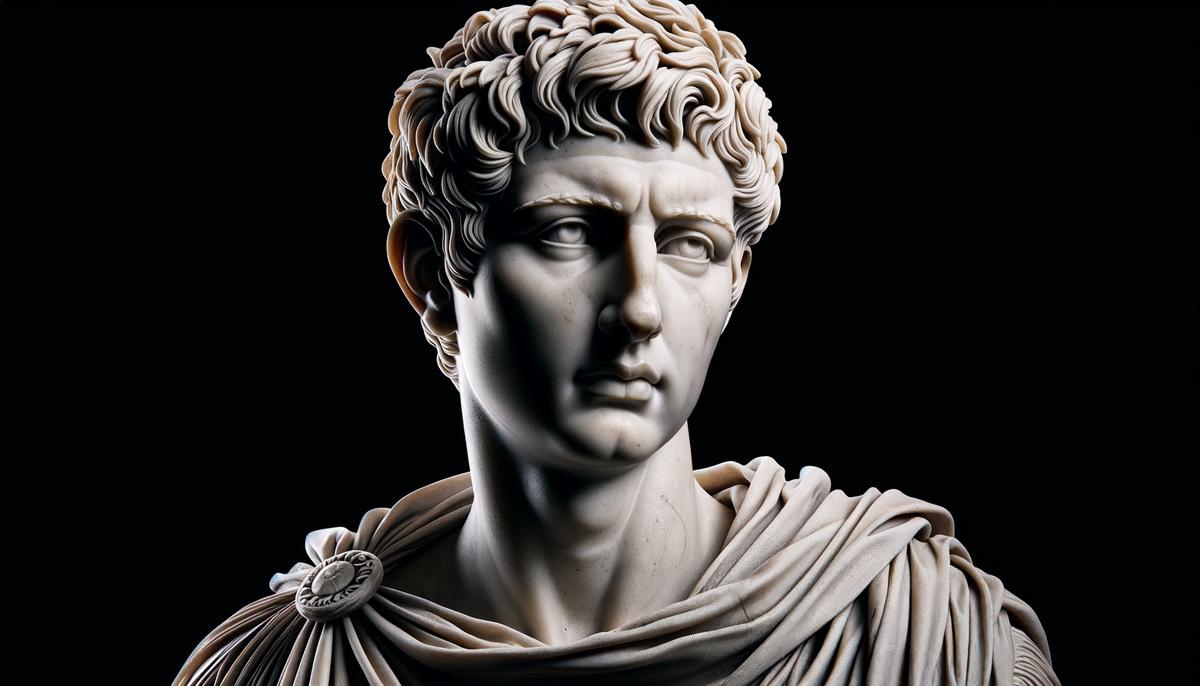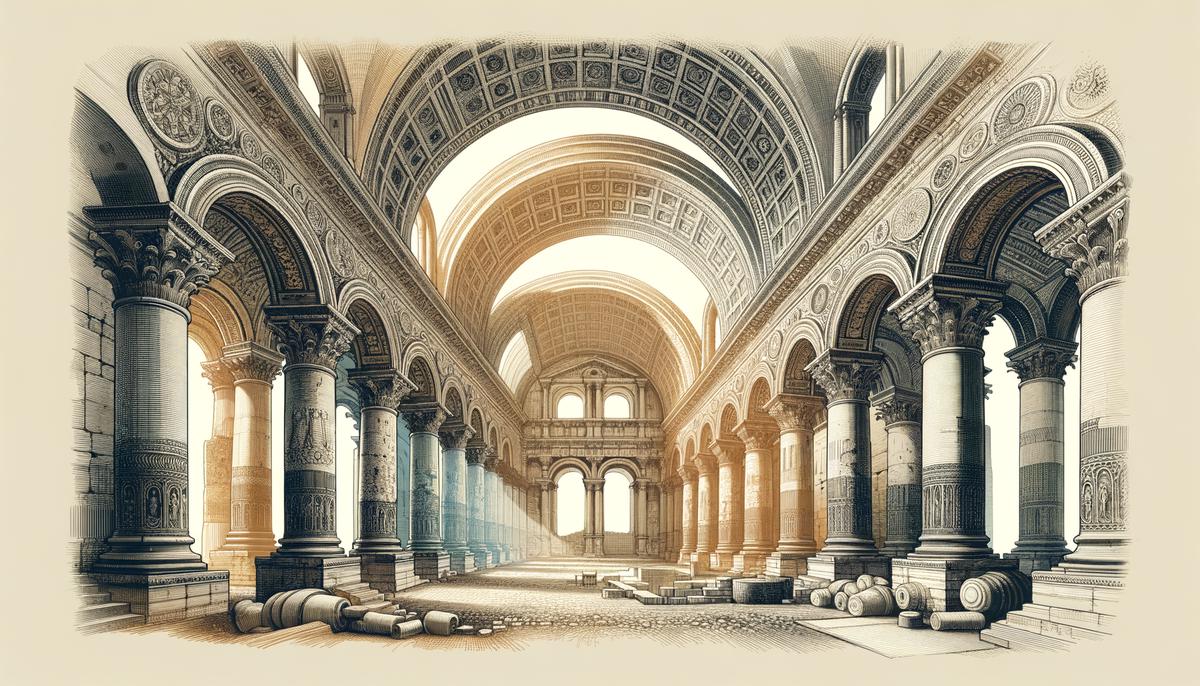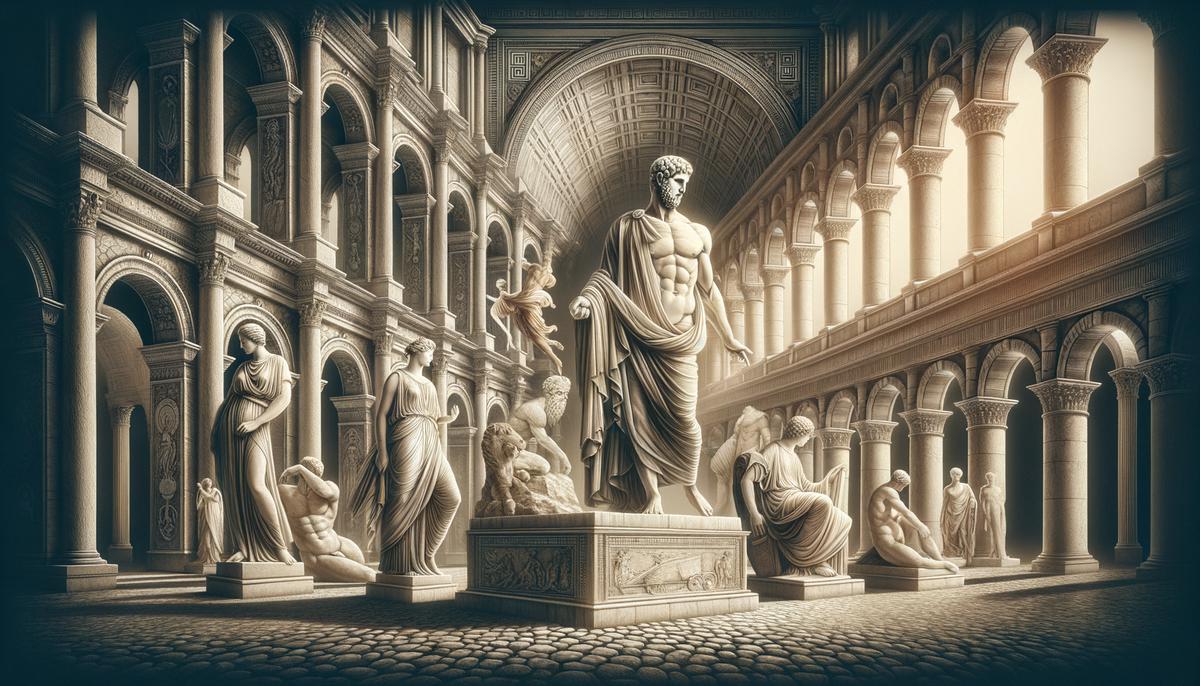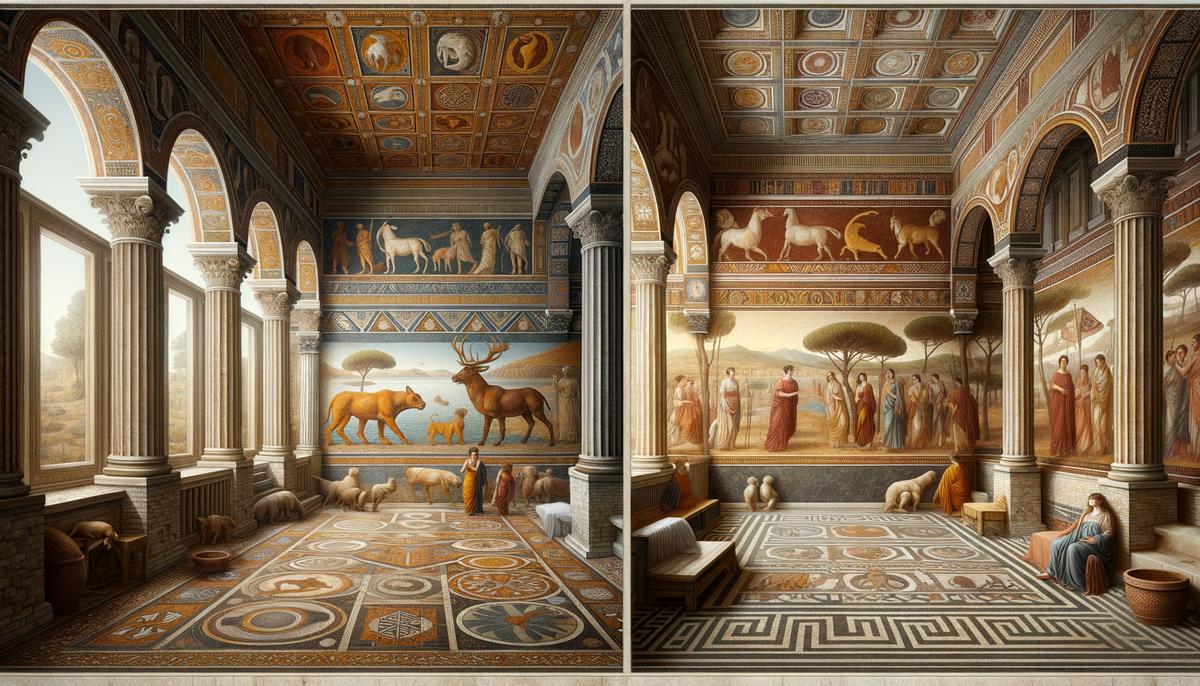Roman art and architecture are testaments to an era of creativity and innovation in cultural expression. The journey through Roman artistic achievements offers a glimpse into a civilization that drew inspiration from the Greeks while carving its own indelible mark on history. This narrative explores the layers of Roman artistry, from sculpted marble and bronze that captured human emotion to architectural marvels that continue to inspire. It's a story that weaves through time, inviting us to appreciate the legacy left behind by Roman hands and minds.
Roman Sculpture
Roman sculpture began with the Etruscans, heavily influenced by the Greek fascination with the human form, yet it evolved to carve out its unique path. The transition moved from the stiff forms of earlier works to more dynamic and realistic representations, showcasing a marked progression in their artistic endeavor.
A defining characteristic of Roman sculpture was the emphasis on realism, capturing not just physical accuracy but also the emotional state and personality of the subject. It was a significant shift — the figures told stories, carried the weight of political power, or depicted deities with a sense of presence and humanity.
The portrayal of emperors and deities held particular significance, serving both religious and political purposes. Statues like Augustus of Prima Porta exemplify the mingling of symbolism and statecraft, portraying the emperor in a god-like stance to signify his divine right to rule.1
Roman sculptors mastered various techniques to achieve these lifelike qualities, employing a keen eye for detail in textures, fabric folds, and unique expressions. Advances in bronze casting allowed for greater expressive freedom and detail in statues and busts.
Greek art's influence on Roman sculpture is undeniable. Romans inherited the Greeks' expertise in portraying the human body and their interest in humanism. However, Romans pushed beyond to embrace realism, making their sculptures more accessible and relatable.
Roman sculptures were placed in public spaces, homes, temples, and tombs, serving as religious icons, political propaganda, social commentaries, and historical records. As time progressed, Roman sculpture underwent transformations, reflecting changes in society, politics, and artistic tastes. Today, these statues stand as markers of history, reminding us of Rome's power, artistic prowess, and the enduring appeal of capturing the human essence in stone and metal.

Roman Architecture
Roman architecture is a testament to ancient ingenuity, creativity, and technological advancements. The architecture of ancient Rome was a marvel of engineering and design, reflecting the empire's grandeur and leaving an enduring legacy that still influences modern structures. Romans took architectural principles from the Greeks and expanded upon them, utilizing a diverse array of building techniques and structural innovations, such as the widespread use of arches, vaults, and concrete. The grand Colosseum and the Pantheon are two iconic examples spotlighting these innovations.
One key element of Roman architecture was the arch. Employing this structural element allowed Romans to span larger spaces than ever before, giving rise to expansive interiors. The arches carried weight more efficiently, providing critical support for the construction of vast aqueducts, monumental bridges, and grand public buildings.
Vaults, arches extended in depth, further embellished Roman architecture. These architectural elements introduced aesthetic grandeur and facilitated the creation of multi-level complexes, supporting Rome's bustling urban life.
Concrete was another game-changer in Roman construction. This ancient material enabled feats previously thought unimaginable. Unlike the restrictive qualities of stone blocks, concrete's moldable nature allowed architects to experiment with shapes and sizes, notably the dome.
The Pantheon's dome is a crowning achievement of Roman architectural innovation. It's the largest unreinforced concrete dome in existence, with an oculus at its center allowing light into the vast marbled interior below.2 The dome's perfect hemisphere seems a work of great skill and precision.
The Colosseum is another engineering marvel showcasing Roman prowess. This elliptical amphitheater utilized arches distributed over multiple levels, serving both aesthetic and structural functions. Combining Doric, Ionic, and Corinthian orders vertically, the Colosseum was a visual spectacle and an architectural representation of Rome's grandeur.3
Roman architecture balanced utility and visual appeal. Structures served communal needs yet conveyed narratives of power, divine affiliation, and societal order through meticulous designs and craftsmanship.
Roman architecture resonated with the Republic's ethos, blending ambition, structural marvels, and an indelible mark on human civilization. It wasn't just about constructing buildings; it was about cementing Rome's legacy, sturdy as the arches that adorned their aqueducts, lasting as the oculus in the Pantheon's dome. Thus stands Roman architecture, a testament to an empire that envisioned eternity in every structure it raised—groundbreaking achievements etched into the fabric of human history.

Greek Influence on Roman Art
Centuries ago, the Romans looked at Greece with admiration and a desire to make its art their own. Thus began an era of Hellenistic influence on Roman art, a cultural exchange that shaped the foundation of Roman artistic expression.
When delving into Roman sculpture, Greek influences are evident. Roman artists didn't just borrow Greek aesthetics; they absorbed them, making tweaks along the way. While Greek artists pursued an idealized humanity, Romans pursued realism. Despite this difference, the foundational Greek influence is undeniable.
Greek temples, adorned with Doric, Ionic, and Corinthian columns, served as direct inspirations for Roman architecture. Romans took these orders and applied them to grand public edifices and arenas. The Pantheon and the Colosseum stand as tributes to a Greek architectural lineage, albeit adapted to fit Rome's ambitions.
Yet, Romans didn't merely mimic; they innovated with the arch, vault, and dome. These elements became architectural signatures distinguishing Roman prowess. They transformed static Greek façades into dynamic spaces that could host large crowds and religious ceremonies.
The synthesis between Greek and Roman styles forged a unique artistic identity that echoes through history. This fusion blended Greek art's refined elements with Roman art's robust textures, creating an experience that transcends time.
Romans adopted Greek gods and myths, albeit with a Roman interpretation. Public squares and baths borrowed heavily from their cultural brethren but were stamped with Roman utility and grandeur.
Greek art's influence on Roman traditions was formative and transformative, shaping an era where art narrated powerful stories, architecture reached new heights, and cultures intertwined. Today, we traverse a world where Greek elements reverberate amidst Roman grandeur—a testimony to art's power to transcend culture, time, and geography.

Roman Mosaics and Paintings
Mosaics and paintings were cornerstones in the vast arena of Roman art, piecing together the intricate puzzle of Roman aesthetics and culture. Beyond the triumphs of architecture and the lure of sculptures, these realms captured the essence of Roman life.
Roman mosaics were more than mere decorative elements. They were narratives set in stone and glass, chronicling tales of gods, heroes, and Dionysian rites. Walking through a Roman villa rich with mosaic art was akin to flipping through an illustrated storybook of the era.
The crafting of mosaics was meticulous, a symphony orchestrated with tiny pieces of colored stone, glass, and ceramic. Artists wielded these tesserae to create vivid scenes, from lush landscapes to mythological escapades. The beauty of Roman mosaics lay not just in their artistic execution but in their ability to capture moments of everyday luxury and divine imagery.
The grand floors of Pompeii and Herculaneum offer a captivating glimpse into the Roman penchant for intricate designs and storytelling through mosaics. The famed Alexander Mosaic depicts Alexander the Great's conquests underfoot,4 while simpler designs reveal Roman leisure and domesticity.
Much like mosaics, Roman paintings were conduits for revealing the societal pulse of Rome. Through frescoes and panel paintings, Roman artists depicted a spectrum of human emotion, religious reverence, and philosophical musings on plaster and wood. Frescoes embellished the walls of public buildings and private homes, creating immersive experiences that transported viewers to landscapes filled with flora, fauna, and gods.
The realms explored by Roman painters were boundless. In the Villa of the Mysteries in Pompeii, frescoes depict the enigmatic rites of initiation into the Dionysian Mysteries.5 In homes and bathhouses, frescoes provided an escape into idyllic landscapes.
Technique was paramount; frescoes came alive while the plaster was still wet, demanding swift, calculated strokes from the artists. This immediacy lent a vibrancy to Roman paintings, a liveliness that still communicates stories from across millennia.
Paintings also adorned sarcophagi and tombs, echoing beliefs in the afterlife with poignant introspection or vibrant imagery filled with symbolism and hope. These final resting places housed courtly vignettes and scenes marrying mythology with mortuary traditions, providing a valuable glimpse into Roman beliefs surrounding death and eternity.
Together, mosaics and paintings served as the Romans' canvas for expression—mortal desires draped in divine allegories. They beautified spaces sacred and mundane alike, making art an intimate part of the Roman daily life. Roman mosaics and paintings ensured that every aspect of existence was a subject worthy of immortalization.
Romans pursued a dialogue with the divine and the decadent through art. Mosaics and paintings allowed them to anchor their aspirations and achievements in perpetuity—each piece a testament to a civilization deeply entrenched in the pursuit of beauty, narrative, and legacy. Through these remnants of pigment and tesserae, we stroll through ancient Roman corridors filled with stories—a reminder of yesteryears' wonders etched into the fabric of history.

The enduring appeal of Roman art and architecture lies not just in its aesthetic grandeur but in its ability to convey the depth of human experience and innovation. Through sculptures that bring life to stone, buildings that defy the constraints of their time, and mosaics that narrate tales of gods and men, Roman artistic endeavors continue to resonate with us. They remind us of a civilization that, in its quest for beauty and expression, reached heights that still captivate our imagination. This legacy, etched in marble, bronze, and the annals of history, underscores the profound impact of Roman creativity on our collective cultural heritage.
- Zanker P. The Power of Images in the Age of Augustus. University of Michigan Press; 1988.
- MacDonald WL. The Pantheon: Design, Meaning, and Progeny. Harvard University Press; 2002.
- Hopkins K, Beard M. The Colosseum. Harvard University Press; 2011.
- Cohen A. The Alexander Mosaic: Stories of Victory and Defeat. Cambridge University Press; 1997.
- Gazda EK, ed. The Villa of the Mysteries in Pompeii: Ancient Ritual, Modern Muse. Kelsey Museum of Archaeology and the University of Michigan Museum of Art; 2000.
























